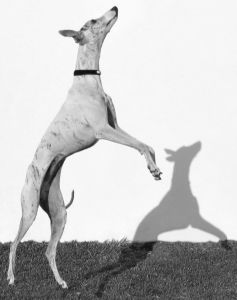|
The Basics of Dog Body Language
The purpose of this article is to help the reader decipher dog body language and other subtle signs that may indicate extreme discomfort or feelings of dread or even a call for help. It is hoped that after reading this piece, the reader will learn how to better understand his dog, especially during times of the latter's distress. Reading the body language of our dogs is an important stage of proper dog care, after all. To understand what a dog is saying with his body gestures, it is important to know what body part he is using to convey his messages. The tail is one of a dog's favorite body parts to use when expressing his feelings. When a dog wags his tail, we all know that he is expressing his happiness. When a dog's tail is pointing up, he is showing that he is confident and alert. When a dog's tail is pointing to the ground, we all know that he is afraid of something, hence the idiom "tail between his legs" which is used to indicate a cowardly act. The eyes are also good determinants of your dog's current emotion. Just like human eyes, a dog's eyes can easily be read. Just look at the dog and his eyes will tell you when he's happy (like when he's expecting some cuddling or it's nearing his playtime), or when he's excited (like when he can smell a doggie treat forthcoming), or when he's sad (like when playtime is over and you have to take him back inside his cage or pen). When his head turns away to show the whites of his eyes or when he displays dilated eyes, however, such would also mean that the dog is scared about something.  Barking can likewise tell us what the dog is currently feeling. However, barks are harder to decipher since different dogs are trained to bark for different reasons. Usually, however, dogs bark to call attention to something. Indeed, it may be something as grave as a robber trying to infiltrate the house, or it may be as simple as the dog demanding some attention from his handler. The dog's stance can also be used as a gauge of his disposition. An erect stance, for example, shows confidence. A lowered stance, on the other hand, indicates concern. When reading dog body language, ears also play a crucial role. When the dog's ears are dropped, it signifies that he trusts the people (and other animals for that matter) around him. When his ears are erect, it means the canine is alert and attentive, expecting something that may require immediate action. This may be good or bar. He may be anticipating a fun activity, or he may be guarding himself against a presumed fear. Dog behavior, of course, is the ultimate determinant of the dog's mood. It is also the easiest to read. Dogs, unlike humans, aren't known to be guile. They show what they feel, and they never attempt to hide the same. This is most apparent in the way they act. In conclusion, reading dog body language isn't difficult at all. One merely has to keep an open mind when dealing and observing his dog. The rest, as they say, will come naturally. Subscribe to the Pet Comfort Newsletter
|



